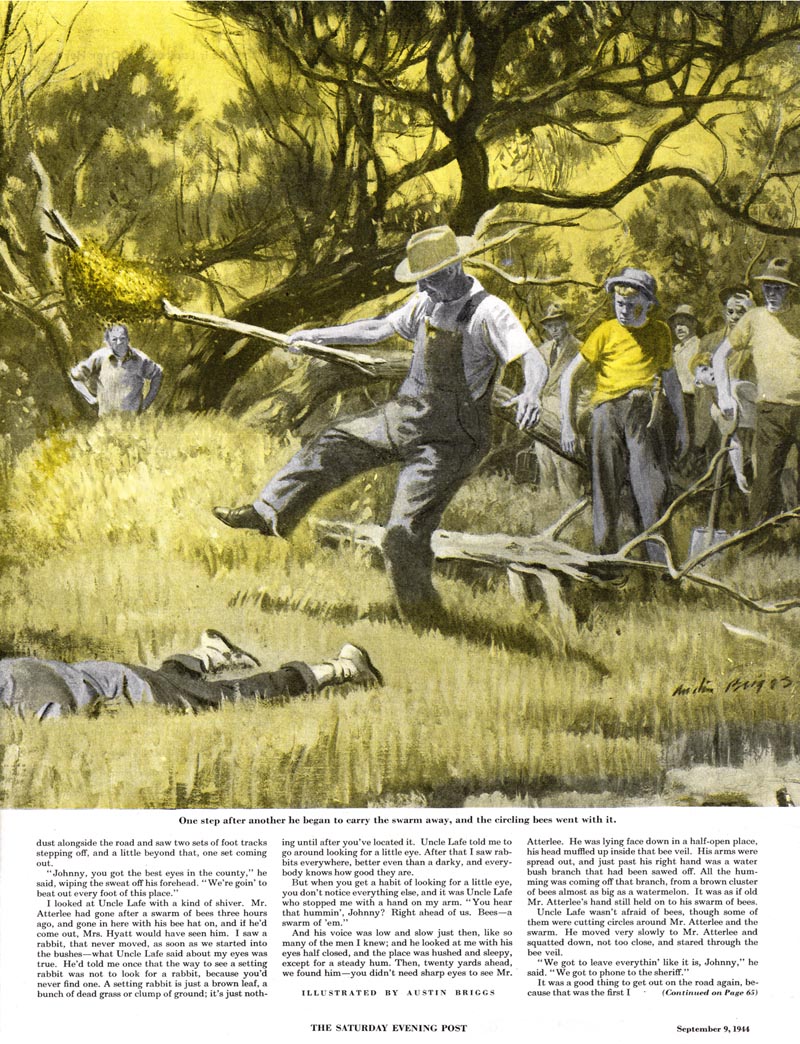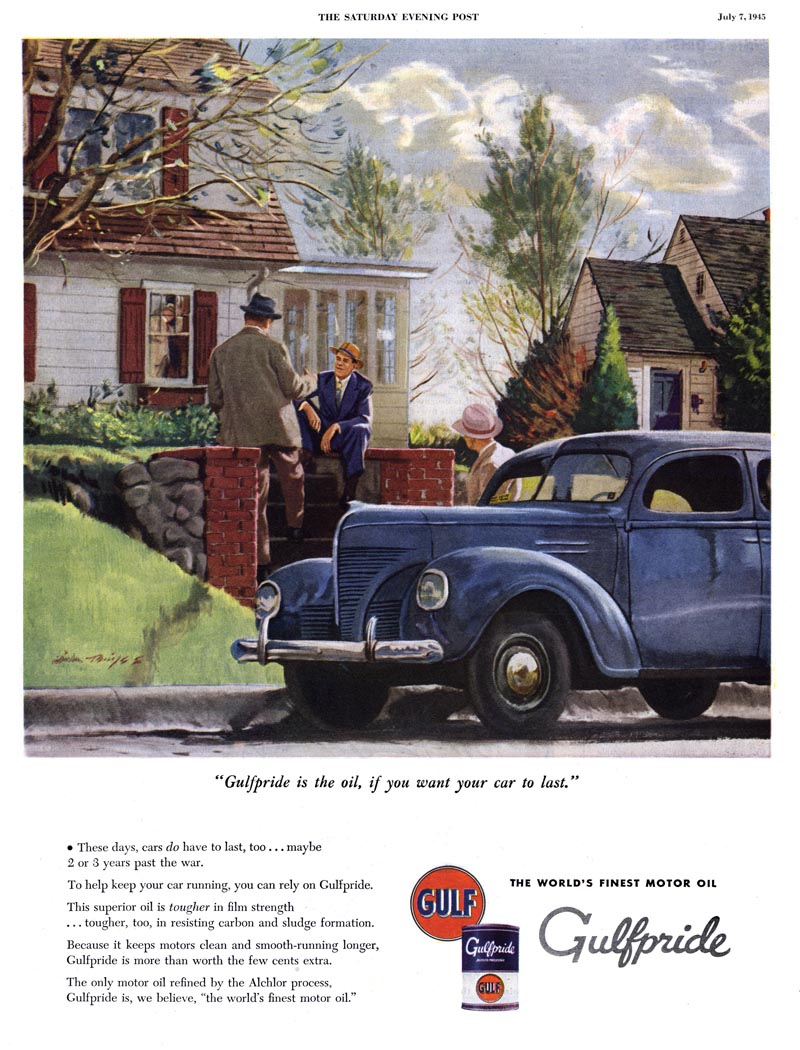
He began to draw at an early age and in high school his work attracted so much attention that he was awarded a scholarship to the Wicker art School. He attended afternoon and evening classes but his interest flagged and he gave it up. He had concluded that Wicker didn't know anything; later, when he was older and wiser, he realized that he had missed some excellent instruction.

Briggs spent one semester at the City College of Detroit after his graduation from high school, but he was still looking for an opportunity to use his drawing ability. His chance came when an illustrator who specialized in automobile pictures took him on as an assistant. Briggs was only sixteen then, but his ability to draw the human figure was considerable, and it became his task to draw in the pretty girls and prosperous men, in a slightly reduced scale, so as to enhance the proportions of the sleek, shiny cars. It was good traing, and thirty-five dollars a week was an excellent salary for a youngster, but he became rebellious when he learned that his employer was receiving a thousand dollars a drawing. He threw up his job, became a free lance and did very well.

But he was dissatisfied with advertising routine and anxious to do story illustration. His first opportunity came in 1927 when he began working for the Dearborn Independent. Later in the year he sent some photostats of his Dearborn Independent drawings to Collier's. He received an encouraging note from the art editor, so he packed up and moved to new york. he first enrolled in the Art Students League and then called upon Collier's. The editor who had encouraged him was leaving but his successor gave Briggs his first big magazine assignment.

For about three years Briggs worked busily. He was attending classes at the Art Students League and studying under the fine draftsman George Bridgman and with Jack Walter Duncan. He also became acquainted with Wallace Morgan. And meanwhile he was drawing illustrations for Collier's, McClure's, Pictorial Review and newspaper advertisements for Cosmopolitan. All these illustrations were in pen and ink, for at the time, Briggs had done little painting in color. He was beginning to be regarded as an important young illustrator when the depression came and Briggs' work disappeared from the magazines.
Excerpted from the October 1950 issue of American Artist magazine, written by Henry C. Pitz
* My Austin Briggs Flickr set.
what a cliffhanger- and some excellent images.
ReplyDeletethanks!
Thanks, tonci; I know you will find the rest of Austin Briggs' story very compelling and thought-provoking, so stay tuned! :^)
ReplyDeleteexcellent stuff as always Leif....austin briggs is one of my all time favorite illustrators....
ReplyDeleteThanks Brian; Oh, I know, believe me! Some of the scans you've so generously donated may just find their way into the mix this week. :^)
ReplyDeleteBriggs was so brilliant... every time I stumble across his work in venues like this, it rerminds me that I should spend more time focusing on him.
ReplyDeleteThedrawing of cow made me think of it was the work of Rien Poortvliet work.
ReplyDeleteAustin Briggs inclines more into painting the modern urban life.
Thanks.
A limited pallet of three colors was always the ultimate challenge for me. Austin makes it look like a walk in the park.
ReplyDeleteFascinating post, Leif.Cant wait for the rest of Briggs' story.I always tend to group him with Fawcett and Sickles for the quality of their linear draughtsmanship.I'd be interested if your readers would add any others to this group.Possibly Dorne? ,I'm not sure.
ReplyDeleteAlso, does anyone know why his work on the Flash Gordon strip was so undistinguished?
Fantastic post, once again. Anything by Briggs is a treat. Also, your Marvin Friedman post's are very inspirational. Can't wait to find out more.
ReplyDeleteThanks for your commitment to this blog.
David; I think it was your post long ago on that small pencil sketch you own that made me really appreciate Briggs. Any focus you choose to put on him will no doubt be a delight to read.
ReplyDeletelouis-etienn vallee; I also think more often of modern, urban subjects when I think of Briggs. His style somehow seems very ... I don't know... sophisticated? But these somewhat earlier works perhaps show a Briggs who has not yet entirely found himself, as we will read in the next couple of days.
Les; a limited pallete of three colours- an interesting challenge - worth exploring. Thanks for the idea!
Hi Leif! This is my first time to visit this blog and I find it very inspiring. Please keep the posts coming.:)
ReplyDeleteLeif, for a limited pallet, try using a cool red (alizarin crimson), yellow ochre, black and white (which is technically not a color). Mix alizarin crimson, yellow ochre and white for the basic flesh colors... reduce the white and add black for the shadows... for a bluish gray color, mix white and black... for a purplish gray color, mix black, white and alizarin crimson... for a greenish gray color, mix yellow ochre and black.
ReplyDeleteThe great Swedish painter Anders Zorn sometimes used these color combinations, when he painted nudes in oils. They really unify a painting.
Tom Watson
Thanks,Björnik - please keep visiting! :^)
ReplyDeleteTom; Thanks for that great advice - I'm going to give it a go! :^)
ReplyDeleteI love Briggs' work. Thanks for posting this! I really enjoyed it! :)
ReplyDelete